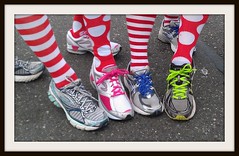The Fundamentals of Running Shoes: Stay Injury Free

![]() photo credit: RVWithTito
photo credit: RVWithTito
As runners, our shoes are the most important piece of equipment we utilize. Accordingly, one of the most important decisions we can make is choosing the right shoes for our foot/running style type. Our shoes absorb the impact of running, help properly align our legs, hips, and spine through stabilization, and keep us balanced. Wearing improper shoes can adversely affect our balance and alignment and, in doing so, it increases our risk of injury.
There are numerous injuries runners can suffer from when wearing the wrong shoes, including painful shin splints, runner’s knee, and various spine problems; but over time, serious damage can be done to your joints and spine.
There are three steps you can take to ensure that you stay injury free.
First: Get help.
Choosing your running shoes shouldn’t be an impulse decision. Asking a high school kid at a chain store or a runner friend which shoe is best for you is also far from ideal. This is because no two feet are the same. For instance, some people overpronate as they run, i.e. a biomechanical abnormality in which the arches of a runner’s feet flatten as his/her weight is distributed inward on their feet. Feet shapes along with running abnormalities and several other factors make everyone’s feet unique. Consequently, one pair of shoes may suit one runner, while causing injuries in another. Our shoes are meant to compensate for abnormalities and ensure a safe, balanced, and aligned run. You should always enlist the help of a professional, i.e. someone with a lot of experience running and choosing others’ running shoes. Usually, local shops that specialize in running are the best places to seek professional help. Professionals watch the way you run and take the following into account:
- Shoe wear on your old running shoes.
- The arches of your feet.
- The type of running you engage in, e.g. marathon, sprints, etc.
- Your foot shape.
- Your gait type (your biomechanics), i.e. the way your heel hits the ground as you take strides.
Second: Help Yourself.
When you go to get fitted, you should also take the step to ensure that you find the perfect pair of shoes. Probably not something most runners think about is that the time of the day that you go to get fitted matters. As we run, our feet expand. Even when we’re not running, however, our feet expand and contract throughout the day. Thus, late afternoon, when our feet have typically reached their maximum expansion, is the best time to get fitted.
Third: Put Old Shoes to Rest.
Finally, shoes must be retired when they are worn. This is all dependent on the runner’s weight, what surface he/she runs on, how often he/she goes running, etc. For many this means every 300 to 500 miles, i.e. 6 to 9 months. Here are some indicators that you need new shoes:
- You begin to repeatedly suffer from injuries/pains, like shin splints or joint pain.
- Your shoe fails the twist test. Hold the heel of your shoe with one hand and the toe with another. Twist both hands inward. If your shoe twists very easily, it’s time for new shoes. If your shoe is difficult to twist, then it is still capable of providing you with the necessary stability and cushioning.
Gina Williams is an avid runner and writer bringing to us information on the importance of our running shoes. Gina spends the majority of her professional life writing about motorcycle accidents.






This was a really interesting article with a lot of valid points. I actually recently started my own website that is all about helping people find the right shoes.